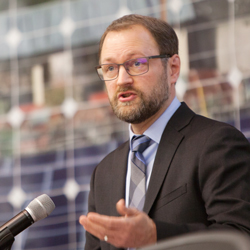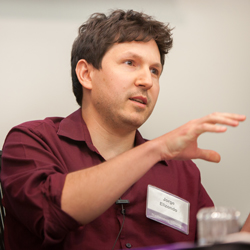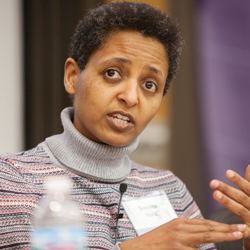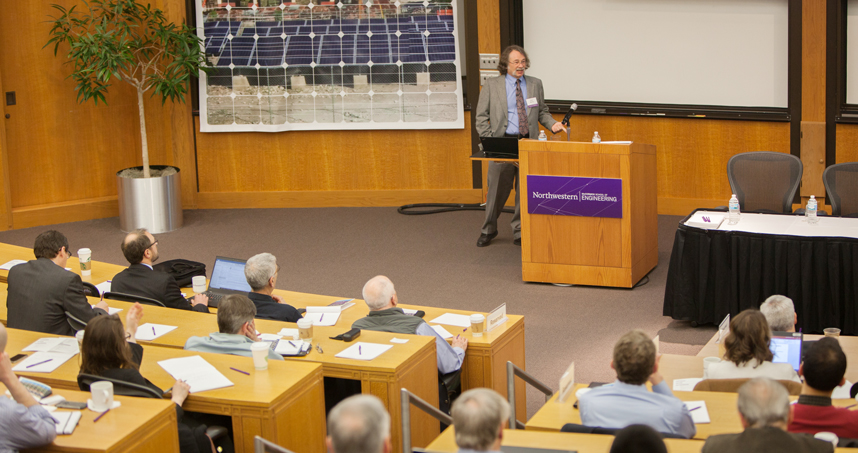Symposium Examines Role of Microgrids in Sustainable Development
“Renewable Energy Microgrids for Sustainable Development” took place April 10
Watch the Symposium on Microgrids
As news of devastating natural disasters hit the headlines on a regular basis, it has become clear that maintaining a sense of normalcy requires assurance of one major need — power.
On April 10, experts gathered at Northwestern’s Symposium on Microgrids: Renewable Energy Microgrids for Sustainable Development to share knowledge about and experiences with self-contained power microgrids in the face of disasters such as Hurricane Maria and the Northern California firestorm, and they discussed how to apply those lessons learned to satisfy power needs around the world.
“Puerto Rico had one giant power grid. If they had several microgrids, not everything would be knocked out at once,” said Julio M. Ottino, dean of the McCormick School of Engineering. “There are implications for developing countries.”
Throughout the day, speakers with backgrounds ranging from academia to government to private industry examined the cultural and economic policy shifts necessary to use sustainable power via microgrids. The goal is to create a reasonable quality of life, education, longevity, and healthcare for all.
A microgrid is a group of interconnected loads and distributed energy resources within clearly defined electrical boundaries that acts as a single controllable entity with respect to the grid, according to the US Department of Energy. Controlled locally, a microgrid can connect — and disconnect — from the main electrical power grid, meaning it can operate in tandem with the main grid as well as work independently in “island-mode.” Microgrids use a variety of energy sources, from traditional fossil fuels to clean sustainable sources such as wind, hydro, and solar power.
The daylong symposium, held at the James L. Allen Center on the Evanston campus,
was Northwestern’s first focused on the topic. Northwestern Engineering, the Northwestern Institute on Complex Systems (NICO), and the Buffett Institute for Global Studies served as co-sponsors.
Clean energy for development
As the world economy shifts, population booms, technology grows exponentially, and costs for clean energy drop, now is a defining moment for sustainable energy and microgrids.
In 2015, the United Nations set 17 sustainable development goals, including increasing the share of renewable energy, and ensuring universal access to affordable, reliable, and modern energy services by 2030.
 “It’s clear that clean energy is critical to sustainable development and economic growth,” said Northwestern Engineering’s Eric Masanet, associate professor of mechanical engineering, during the symposium’s opening talk.
“It’s clear that clean energy is critical to sustainable development and economic growth,” said Northwestern Engineering’s Eric Masanet, associate professor of mechanical engineering, during the symposium’s opening talk.
With 7 billion people now on the planet and an estimated 2 billion more by 2050,
population growth will be centered in underdeveloped regions, such as sub-Saharan Africa, India, and Southeast Asia — places with the least reliable access to consistent power.
“These are the regions that are of the greatest need of technological progress and energy access,” Masanet said.
Currently, more than 1 billion people worldwide lack access to electricity. Most of those people are in the developing world, according to the International Energy Agency.
“It’s clear that electricity plays a pivotal role in meeting the UN goals,” Masanet said. “It provides lights for general household tasks or students studying when the sun goes down. It allows for refrigeration to keep food fresh. It allows access to the internet and computers.”
Ideally, microgrids will be powered on clean energy. Nearly 6.5 million premature deaths occur annually because of air pollution from fossil fuels.
“Renewable microgrids could be one solution that helps us decouple growth from CO2 emissions,” Masanet said.
Reliability and resilience
The three big motivations for moving to a microgrid are cost savings, lower emissions, and increased reliability and resilience.
Reliability focuses on the statistical expectation of power availability during routine conditions over a year, while resilience is the ability to prepare for and adapt to changing conditions and recover rapidly from disruptions.
Natural disasters test these standards. “Reliability is a great thing and we always want more of it,” said Chris Marnay, principal of Microgrid Design of Mendocino. “But it is expensive.”
The tragic aftermath of the Japanese earthquake and tsunami in 2011 had a bright spot. The excellent performance of Tohuku Fukishi University’s microgrid during the crisis influenced energy policy in Japan, easing regulations to allow the system to grow. Now, the entire town of Higashi-Matsushima is being rebuilt to be a disaster-resistant eco city using a microgrid.
Like the East Japan Earthquake, Super Storm Sandy tested a university’s microgrid system.
New York University operates a microgrid under 4th Street in Manhattan. During the 2012 storm, NYU’s facility successfully disconnected from the damaged main power grid and functioned as a power island. This inspired the state to create a grant to promote clean energy and reduce costs while building reliable and resilient networks.
“You can see a trend here,” Marnay said. “If you want more microgrids, I’m afraid you have to get through a decent disaster first.”
“One of the problems with this kind of business model where we all rush in after a natural disaster is that what everybody really wants is for it all to be built back as fast as possible,” he added. “You may have a better vision but what people want is their house back.”
Trial by fires
At home in bed in the wee hours of October 7, 2017, Craig Wooster smelled smoke.
The general contractor and project manager of Stone Edge Farm MicroGrid Project, Wooster knew what was happening — the fires raging in the drought-ravaged wine country were heading toward his employer’s energy-conscious vineyard.
While still at his own home miles away, he switched the farm’s innovative, sustainable microgrid system into island mode from his phone.
“We pulled away from the grid,” Wooster said. “For a while we were told that the only functioning lights were from the microgrid of Stone Edge Farm.”
Along with producing world-class wines, the lush 16-acre winery owned by John “Mac” McQuown and his wife Leslie is a world-class leader in microgrid use, research, and development.
“It’s a living experiment and something fully functional, completely independent of the power grid,” Ottino said.
Lego-style customization
During his internship at the Stone Edge Farm Microgrid, Jorge Elizondo, now lead engineer and co-founder of Heila Technologies, saw the challenges of customizing microgrids.
“You go to a project, and you have to start from scratch,” he said. “You have a lot of different pieces, you have a lot of different batteries, you have a lot of different technologies you have to integrate.”
 Elizondo likened microgrid systems to an orchestra. “In an orchestra, you have a conductor who sends signals to every single performer in the orchestra,” he said. “That signal is simple, but every member of the orchestra has to have intelligence of their own.”
Elizondo likened microgrid systems to an orchestra. “In an orchestra, you have a conductor who sends signals to every single performer in the orchestra,” he said. “That signal is simple, but every member of the orchestra has to have intelligence of their own.”
He saw a gap in putting intelligence into the performers of the orchestra. “That’s where my company is working,” he said.
Elizondo’s solution involves a Lego-style building-block approach, allowing microgrid owners to seamlessly add or remove different intelligent modules to a base system over time — something previously not possible.
Many of Heila Technologies’ modular pieces are being tested at Stone Edge Farm MicroGrid.
Community driven
Customization must consider community behavior.
“It’s important to focus on people and projects,” said Stephen Walls, energy transition initiative program lead at the US Department of Energy who focuses on helping remote communities. “You can’t change one piece of a system that small without very serious ramifications to policy, engineering, and economics.”
For instance, the small islands off the coast of Maine have specific energy needs, with spikes in need for heating the winter and different needs to accommodate a large tourist population in the summer. Residents need to change their behaviors to accommodate the demand cycles for renewable energy.
However, completely clean energy might not be possible everywhere, said Ben Kroposki, director of National Renewable Energy Laboratory.
“There will still be some customers who are not close enough to renewable resources,” Kroposki added.
Scaling up
Because access to energy via microgrids is relatively new, many questions remain, said Jay Taneja, assistant professor of electrical and computer engineering at the University of Massachusetts, Amherst.
For instance, is there enough demand for power?
“There might be enough identified customers, but those customers might not purchase enough electricity to sustain that business,” he said.
Taneja cited work in East Africa. “The big problem here is that we’re not seeing enough growth in demand,” he added.
Groups there are working to change consumer behavior. Financing for appliances — like televisions and cold storage units — is offered to customers with the ultimate aim of increasing electricity demand.
It’s a model with a proven track record. In the late 1800s, Chicago’s Commonwealth Edison pushed appliances on consumers to weave electrical appliances into the fabric of people’s lives.
Load factors increased and stabilized, and costs dropped, Taneja said.
Searching for technical solutions
Others are looking to improve technology to increase microgrid efficiency.
 “There are times when we have excess electricity, which can be a problem for the grid,” said Northwestern Engineering’s Sossina M. Haile, Walter P. Murphy Professor of Material Science and Engineering.
“There are times when we have excess electricity, which can be a problem for the grid,” said Northwestern Engineering’s Sossina M. Haile, Walter P. Murphy Professor of Material Science and Engineering.
Haile’s lab is working on relatively uncharted territory — an electrolyzer that can operate in forward and reverse. Sometimes, it functions as a fuel cell and sometimes as storage, operating essentially as a battery.
“Your costs could go down by a factor of two because you don’t have to have two separate systems,” she added.
The challenge comes in designing the electrodes. “We now are requiring these catalysts to do two different reactions,” Haile said.
Energy access outlook
There is hope for the UN’s goals of universal energy access, said Hannah E. Daly, energy analyst and energy access lead at the International Energy Agency.
Since 2000, 1.2 billion people have gained energy access around the world, with 500 million coming in India. “India is on track for full electrification by 2030. This will be a really tremendous achievement,” Daly said.
In sub-Saharan Africa, where nearly 600 million people remain without electrical access, microgrids might not be the best cost-effect solution — at least at first.
“Microgrids have a relatively low role to play because we assume that the density of power demand is very low,” Daly said. “But once you bring the power demand up and every house wants power, in that case, that makes that case for microgrids.”
Daly emphasized the importance of access to clean cooking, an oft-overlooked area. The lack of clean cooking fuel impacts the environment, health, and women’s equality.
“2.7 billion people today still do not have access to clean cooking — and that number is the same as it was in 2000,” she said. “And that fact is really shocking,”
Research published in the World Energy Outlook Special Report “Energy Access Outlook 2017: From Poverty to Prosperity,” shows that women and children spend more than 5 hours each day gathering wood and cooking on air polluting stoves, which contribute to 2.8 million premature deaths each year.
Microgrids from an economic, human perspective
Wrapping up the symposium, economic and anthropological experts shared their perspectives of the current opportunities and challenges facing microgrid installations in the developing world.
As developing countries have undergone increased efforts to improve energy access during the last two decades, economists have begun analyzing the effects of energy access in these rural areas. Fiona Burlig, a postdoctoral scholar in the Department of Economics and the Energy Policy Institute at the University of Chicago, is studying the relationship between increased energy access and economic growth. She shared her research into whether recent rural electrification in developing countries has improved economic benchmarks in those areas.
Burlig studied the economics of rural electrification in the context of India’s national electrification program, which was launched in 2005 to provide power access to more than 100,000 un-electrified villages across 27 Indian states. Burlig compared villages 3-5 years after electrification to villages that were not impacted by the program in order to determine the economic impact of the large-scale energy infrastructure project.
According to Burlig, nighttime satellite images showed a notable increase in electricity use in the program-eligible villages, a signal that the program was connecting houses and increasing energy access. But when she measured a series of economic indicators, including employment, television ownership, income, and poverty rates, the results revealed negligible economic improvements.
“Evidence from the latest research supports that electrification may not dramatically transform the economy in these rural regions,” Burlig said. Still, she cautioned her results did not necessarily mean that people weren’t happier with greater energy access.
“It’s challenging to measure true happiness in an economic survey,” Burlig said. “We need to do more work to quantitatively determine whether rural electrification is worth it, and if microgrids could be good substitutes for grid-scale electrification.”
Turning attention to the economics of microgrids in Africa, Kelly Carlin addressed the challenge of commercial viability for microgrids in sub-Saharan Africa. As senior associate at the energy and sustainability think tank Rocky Mountain Institute, Carlin is working with African governments and utility companies to incorporate microgrids and solar home systems into its energy plans, focusing on how to scale these sustainable technologies.
According to Carlin, growth in the microgrid market has lagged in the region despite nearly $400 million spent proving its viability. Many territories in sub-Saharan Africa use energy supplied from diesel generators, which provide a levelized cost of electricity (LCOE) between $.35 and $.60 cents. “The best microgrid companies in Africa are doing $.80 cents LCOE,” Carlin said. “That makes it difficult to compete with the diesel generator market.”
Carlin argued that the cost of project development, poor capacity utilization, a lack of financing options, and unpredictable and ineffective policy can be blamed for the limited market growth of microgrids in the region. But there’s hope: he and his team are working to identify opportunities across the microgrid value chain, from hardware to finance to customer engagement, that they believe could lower the LCOE of microgrids 60 percent by 2020, making it a viable and competitive energy source in the region.
“Microgrids need to be considered as part of a master rural electrification plan that looks at where grid extension makes sense and where microgrids are a better choice,” Carlin said.
Shifting to a human-centered perspective of the potential impact of microgrids, Sera Young, assistant professor of anthropology at Northwestern, applied her research investigating the causes and physical, psychological, and social consequences of food and water insecurity, with a focus on maternal and child undernutrition in low-resource settings like sub-Saharan Africa.
Currently, Young is leading the development of a cross-culturally valid scale to measure household water insecurity in 27 sites around the world. She believes a similar scale could be used to analyze household energy insecurity.
Leveraging her expertise researching the consequences of food and water insecurity, Young hypothesized that improved energy security could increase income generating activities, enhance the diversity of available food sources, and reduce the prevalence of respiratory infections among women who rely on indoor fires to cook food. Maternal depression and stress, common among women in the region that face food and water insecurity, would likely also improve with increased energy access.
Young added that better understanding energy insecurity in sub-Saharan Africa could inform where microgrid installations would be most beneficial, as well as reveal the short and long-term cost effectiveness of electrification projects.
“Right now, we don’t have the tools to measure household energy insecurity at a fine level,” Young said. “It’s really the next frontier in understanding the interface between engineering endeavors and global public health impacts.”




